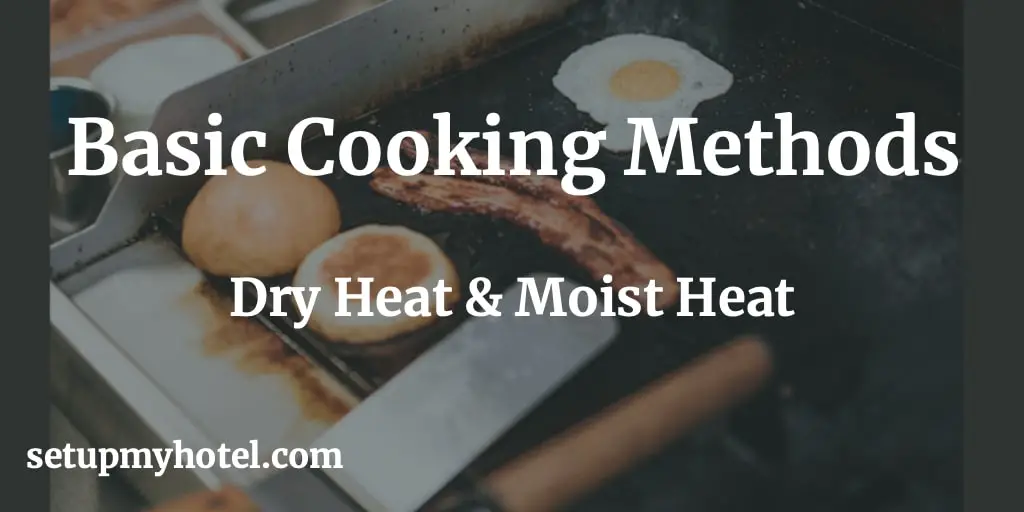Basic Cooking Methods With Dry Heat and Moist Heat
Cooking methods can be classified into ‘Moist Heat’ and ‘Dry Heat’, The Moist heat methods are those in which the heat is conducted to the food products through boiling water (Eg: water, stock, sauce, etc) or by steam. Dry heat methods are those in which the heat is conducted without moisture i.e. by hot air, hot metal, radiation, hot fat, etc.
The Executive Chef and the Sous Chef should be responsible for ensuring that appropriate food cooking methods are followed by the kitchen staff. The hotel training and HRD department should develop and implement proper written Kitchen SOP’s to ensure the same is implemented correctly throughout all the food preparation outlets.
Cooking Methods Standard Procedures:
- Moist heat cooking methodA method in which the heat is conducted to the food product through water by boiling or steam eg: BoilingBoiling - A moist heat cooking method that uses convection to transfer heat from a hot (approximatel..., blanching, steaming, parboiling, stewing, braising, etc.
- To boil means to cook in a liquid that is bubbling rapidly, the water temperature is about 212º F (100º C).
- To simmer means to cook in a liquid that is bubbling very gently. the temperature is about 185º to 205º F (85-96º C).
- To poach means to cook in a liquid, usually a small amount, that is hot but not bubbling.
- Temperature is about 160-180º F [71 to 82º C]
- To blanch means to cook an item partially and very briefly, usually in water.
- To steam means to cook by direct contact with steam.
- StewStew: Long; slow cooking in liquid or syrup. means simmering food in a small amount of liquid and is usually served with the food.
- Parboil means to cook foods partially in a boiling or simmering liquid.
- Braise means to cook foods that are covered in a small amount of liquid and usually done after preliminary browning (although occasionally without browning as well.)
- Sweet means to cook slowly in fat browning occasionally under a cover.
- ReduceReduce - To boil or simmer a liquid to a small volume. Usually; this is done to concentrate flavours... means to cook by simmering or boiling until the liquid quantity is decreased.
- DeglazeDeglaze - The removal of caramelised sugars and other food particles from a pan by swirling with liq... is to swirl a liquid in a sauté pan, roast pan, or another pan.
- Dry heat cooking method
- Dry heat methods are those in which the heat is conducted without moisture eg: baking, barbeque, broiling, deep fry, glazing, etc.
- Baking means cooking foods by simmering them and then exposing them to hot dry air. It is similar to roast but it usually applies to bread, pastries, vegetables, and fish.
- Barbeque means cooking in a grill over host coal, or an enclosed container. It is often done with a seasoned marinade or basting sauce.
- BroilBroil / Broiling - The cooking of a food item with radiant heat. means cooking with radiation from above.
- Deep fry means the foods are submerged in hot fat.
- FryFry / Frying - To cook in hot oil or fat. means the foods are cooked in a hot fat.
- GlazeGlaze: Applying a thick liquid over the surface of an item to give a final glossy look. means giving an additional layer on the surface of a food by applying a sauce, aspic, sugar, or icing, or by browning or melting under a broiler or Salamander or in an oven.
- GriddleGriddle - The process of cooking food on a flat; solid surface. means to cook on a flat, solid cooking surface called a griddle.
- GrillGrill / Grilling - The cooking of food item over an open heat source on a screen or grid. means to cook in an oven grid over a heat source.
- Pan-broil means to cook uncovered foods on a skillet or sauté pan without fat.
- Pan frying means cooking a moderate amount of fat in the uncovered pan.
- En PapillotePapillote - French term denoting the cooking of an item wrapped in paper or possible foil. means the foods are wrapped in paper or foil for cooking so that foods can be baked or steamed in their moisture.
- Sauté means to cook quickly in a small amount of fat.
- SearSear - To brown the surface of a food item by a short application of high heat. This process is used... means to brown cook the surface of food quickly at a high temperature.
Training Summary questions:
Q1. What is the purpose of this SOP?
Q2. What are the two basic cooking methods?
Q3. How to simmer the food while cooking?
Q4. What is glazing or glaze?
Q5. Give a few examples of the dry heat cooking method.
SOP Number: Kitchen / F&B Production SOP – 19 Department: Kitchen / Food Production - Basic Cooking Methods Date Issued: 1-Dec-2018 Time to Train: 20 Minutes










